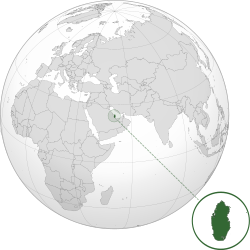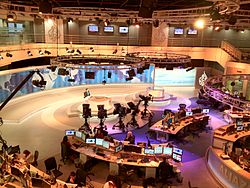| Name | Industry | Sector | Headquarters | Founded | Notes | Status |
|---|
| | |
|---|
| Al Jazeera Media Network | Consumer services | Broadcasting & entertainment | Doha | 1996 | Multimedia corporation | P | A |
| Barwa Group | Financials | Real estate holding & development | Doha | 2005 | Development | P | A |
| BSI-Steel Building System Integration W.L.L | Basic materials | Iron & steel | Doha | 2006 | Steel company | P | A |
| GSSG Holding | Conglomerates | - | Doha | 1994 | Engineering, aviation, education, automotive company | P | A |
| Gulf Drilling International | Oil & gas | Exploration & production | Doha | 2004 | Part of QatarEnergy | S | A |
| Gulf Helicopters | Consumer services | Airlines | Doha | 1970 | Charter helicopters | P | A |
| Hamad Medical Corporation | Health care | Health care providers | Doha [5] | 1979 | State-owned healthcare provider | S | A |
| International Bank of Qatar (IBQ) | Financials | Banks | Doha | 1956 | Private bank | P | A |
| Kahramaa | Utilities | Conventional electricity | Doha | 2000 | State-owned electrical and water company | S | A |
| Nakilat | Industrials | Marine transportation | Doha | 2004 | State-owned gas shipping company | S | A |
| Nehmeh | Industrials | Diversified industrials | Doha | 1955 | Multidisciplinary company | P | A |
| Ooredoo | Telecommunications | Fixed line telecommunications | Doha | 1987 | State-owned telecommunications provider | S | A |
| Oryx GTL | Oil & gas | Exploration & production | Ras Laffan Industrial City | 2003 | Gas to liquids company | P | A |
| Qatar Airways | Consumer services | Airlines | Doha | 1993 | State-owned airline | S | A |
| Qatar Amiri Flight | Consumer services | Airlines | Doha | 1977 | State-owned VIP airline | S | A |
| Qatar Development Bank | Financials | Banks | Doha | 1997 | State-owned development bank | S | A |
| Qatar Exchange | Financials | Investment services | Doha | 1995 | State-owned primary exchange | S | A |
| Qatar Executive | Consumer services | Airlines | Doha | 2009 | Charter jet subsidiary of Qatar Airways | S | A |
| Qatar Insurance | Financials | Full line insurance | Doha | 1964 | State-owned insurance company | S | A |
| Qatar National Cement Company | Industrials | Building materials & fixtures | Umm Bab | 1965 | Cement manufacturing company | S | A |
| Qatar National Company for Medical Projects | Health care | Health care providers | Doha | 2005 | Healthcare company | P | A |
| Qatar Steel | Basic materials | Iron & steel | Mesaieed | 1974 | State-owned steel company | S | A |
| QatarEnergy | Oil & gas | Exploration & production | Doha | 1974 | State-owned petroleum company | S | A |
| QatarEnergy LNG | Oil & gas | Exploration & production | Doha | 1984 | State-owned natural gas company | S | A |
| QNB Group | Financials | Banks | Doha | 1964 | Commercial bank | P | A |
| RasGas | Oil & gas | Exploration & production | Doha | 2001 | Natural gas company | P | A |
| Salam International Investment Limited | Conglomerates | - | Doha | 1952 | Multidisciplinary company | P | A |
| Seashore Group | Conglomerates | - | Al Khor | 1989 | Multidisciplinary company | P | A |


